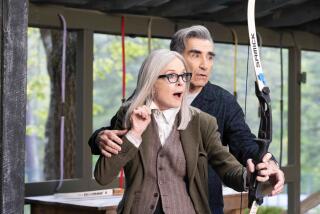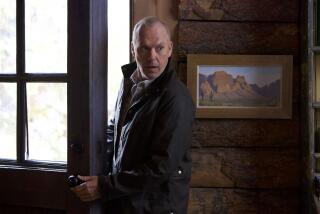Comic master’s sad decline
- Share via
TCM Archives: The Buster Keaton Collection
Warner Home Video, $40
During the 1920s, Buster Keaton was not only one of the funniest men on the silver screen but one of the most ambitious, groundbreaking filmmakers. Totally independent from big-studio interference, he made such classics as “Sherlock Jr.” and “The General.” Then circumstances led Keaton to sign a contract at MGM. Not only was it one of the biggest movie studios in Hollywood, MGM kept its talent on a tight leash, both in front of and behind the camera. There was no room for extra costs or innovations on the set. Gags had to be tightly scripted in advance.
The comic genius was at the top of his game when he entered this tightly wound world, and a mere five years later he was a forgotten man with a severe drinking problem and a busted marriage.
This three-movie set presented by cable’s Turner Classic Movies features the first three films Keaton made at MGM: 1928’s “The Cameraman,” 1929’s “Spite Marriage” and 1930’s “Free and Easy.”
The Cameraman
Though Keaton wasn’t allowed to direct at the studio -- Edward Sedgwick helmed this and several of his MGM comedies -- his first film is one of the best. It’s filled with sight gags -- notably at an indoor pool where he loses his oversized swimsuit -- and great location scenes of New York City.
Keaton plays a tintype photographer who becomes infatuated with a beautiful young woman (Marceline Day) who poses for a tintype. After losing her in a crowd before he can give her the photo, he finally tracks her down -- she works as an office assistant at the MGM Newsreel office. And before you can say “lights, camera, action,” Keaton has traded in his tintype camera for a movie camera as he tries desperately to get a job with MGM Newsreels.
Extras: Jovial commentary from Glenn Mitchell, author of “A-Z of Silent Film Comedy: An Illustrated Companion,” an introduction by TCM host Robert Osborne and a photo gallery.
Spite Marriage
This was Keaton’s last silent film. He had wanted to make it as a talkie, but MGM was slow in converting from silents to talkies and had only one sound stage equipped for the new medium. So the only sound emanating from the film is a pre-recorded musical score and tacky sound effects, which Keaton hated.
Sedgwick also directed this lukewarm farce, which finds Keaton as the befuddled Elmer, a dry cleaner who is so head over heels in love with a stage star (Dorothy Sebastian) that he has seen her latest play 35 times. Sebastian’s Trilby Drew ends up marrying Elmer to spite her former lover, who has taken up with a blond floozy. A few moments of the Keaton magic come through, as in a slapsticky sequence in which he tries to put a passed-out Trilby to bed, but it’s pretty tame stuff.
Extras: Informative commentary from John Bengtson, author of “Silent Echoes: Discovering Early Hollywood Through the Films of Buster Keaton,” and Jeffrey Vance, co-author of “Buster Keaton Remembered,” an intro by Osborne and a photo gallery.
Free and Easy
Keaton finally got to talk in this creaky musical comedy, but he’s not given many funny lines. Sadly, in several scenes, you can hear his alcohol problem in his voice. Though he gets top billing, he really plays second fiddle to Anita Page and Robert Montgomery as the young love interests. It was lame vehicles like this that sounded the death knell for Keaton’s career at MGM.
Extras: The moving Kevin Brownlow documentary “So Funny It Hurt: Buster Keaton and MGM,” which is hosted and narrated by Keaton’s friend actor James Karen.
More to Read
The biggest entertainment stories
Get our big stories about Hollywood, film, television, music, arts, culture and more right in your inbox as soon as they publish.
You may occasionally receive promotional content from the Los Angeles Times.











